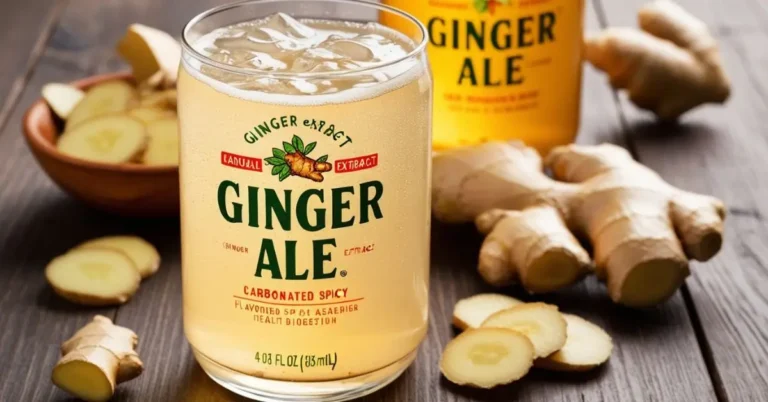Ginger ale is a carbonated beverage that is flavored with ginger, either as an extract or using real ginger root. Its light, spicy flavor, and its perceived health benefits have made it a popular choice globally for both casual drinking and medicinal purposes. Though ginger ale is commonly associated with easing nausea and aiding digestion, it also boasts a rich history and diverse types that make it a beverage worth exploring in detail.
This article delves into the origins, evolution, types, production methods, and health benefits of ginger ale, while also examining its cultural significance and place in the beverage industry today.
The History of Ginger Ale
Early Origins
Ginger has been used for centuries as both a culinary spice and a medicinal herb. Its origins trace back to ancient China and India, where it was prized for its digestive and anti-inflammatory properties. As ginger spread through Europe and the Middle East via trade routes, its use in beverages became more common.
The development of ginger ale as we know it began in the 19th century. During this time, carbonated water was gaining popularity as a drink due to its perceived health benefits, and the combination of ginger with carbonated water was a natural evolution. The early form of ginger ale was often sweetened with sugar and was seen as a refreshing and tonic drink, ideal for calming upset stomachs.
The Birth of Modern Ginger Ale
Ginger ale as a commercial beverage can be traced to Ireland, where it was first created in 1851 by apothecaries who were experimenting with carbonation and medicinal drinks. However, it was the Canadian chemist John McLaughlin who is credited with creating the first modern version of ginger ale in 1904. He introduced “Canada Dry,” a pale, dry version of ginger ale, which was different from its predecessor, a much sweeter, golden-colored ginger ale.
Canada Dry’s success helped to popularize ginger ale around the world, making it one of the staple soft drinks in homes and bars alike.
Types of Ginger Ale
There are two main types of ginger ale, each with its own unique characteristics:
Golden Ginger Ale
Golden ginger ale is the original style of the drink. It is sweet, with a robust ginger flavor that is more pronounced than its modern counterpart. This version was popular in the late 19th and early 20th centuries but has since declined in popularity due to the rise of the dry style. Golden ginger ale tends to have a deeper, caramelized hue, which comes from the use of molasses or caramel in the recipe.
Dry Ginger Ale
Dry ginger ale, also known as pale ginger ale, became the dominant form after the introduction of Canada Dry. It is lighter in both flavor and color, with a more subtle ginger taste that appeals to a broader audience. Dry ginger ale often has a crisper, more refreshing taste and is frequently used as a mixer in cocktails and other beverages.
Ginger Ale Production Process
The process of making ginger ale typically involves three main ingredients: ginger (or ginger flavoring), sugar (or sweeteners), and carbonated water. However, traditional and artisanal ginger ale recipes often include other natural ingredients for added flavor and health benefits.
Ingredients
- Ginger: The core ingredient of ginger ale, ginger provides the spice and warmth that defines the drink. Real ginger root is preferred by many traditional and artisanal producers, though mass-market varieties may use ginger extract or artificial flavoring.
- Sweeteners: Sugar, high-fructose corn syrup, or other natural sweeteners are used to balance the spicy kick of ginger. Artisanal brands may opt for honey or cane sugar, while diet versions often contain artificial sweeteners like aspartame or stevia.
- Carbonated Water: Carbonation is what gives ginger ale its characteristic effervescence. The carbonated water can either be produced naturally through fermentation (as in the case of some artisanal ginger ales) or artificially carbonated.
Traditional vs. Commercial Production
- Traditional Method: The traditional way of making ginger ale involves brewing ginger root with sugar, water, and lemon juice, followed by fermentation. During the fermentation process, natural carbonation occurs as yeast converts sugars into alcohol and carbon dioxide. However, this method produces a very low-alcohol content, usually below 0.5%, classifying it as a non-alcoholic beverage.
- Commercial Production: Modern, mass-market ginger ales skip the fermentation process and are artificially carbonated. Instead of brewing real ginger, many commercial ginger ales use ginger extracts, artificial flavorings, and preservatives to extend shelf life and make production more scalable.
Health Benefits of Ginger Ale
While ginger ale is a sweet, fizzy drink, many people associate it with certain health benefits, primarily due to the ginger content. Ginger is renowned for its anti-inflammatory and antioxidant properties, but does ginger ale offer the same advantages?
Digestive Aid
One of the primary traditional uses of ginger ale is as a digestive aid. Ginger has long been used to help alleviate nausea, indigestion, and stomach discomfort. Although ginger ale may not contain as much ginger as needed for strong therapeutic effects, it is often used as a home remedy for mild stomach ailments, especially nausea caused by motion sickness or pregnancy.
Anti-Inflammatory Properties
Ginger contains bioactive compounds like gingerol, which have been shown to have anti-inflammatory properties. Some studies suggest that ginger may help reduce symptoms of chronic conditions such as osteoarthritis and other inflammatory disorders. However, the actual content of ginger in most commercial ginger ales is minimal, meaning the health benefits are significantly diluted compared to consuming raw ginger or ginger tea.
Hydration and Electrolytes
Ginger ale, like many other carbonated beverages, can help with hydration, especially in cases of mild dehydration. Its sugar content and carbonation make it appealing when someone is feeling queasy or unwell. Additionally, some ginger ales contain small amounts of electrolytes, which can aid in replenishing lost salts after vomiting or illness.
Caution with Sugar and Artificial Ingredients
Despite its perceived health benefits, ginger ale, particularly the commercial varieties, is not without downsides. The high sugar content in many ginger ales can contribute to weight gain, blood sugar spikes, and tooth decay. Additionally, some brands use artificial flavorings and sweeteners, which may pose other health risks when consumed in excess.
Cultural Significance and Uses of Ginger Ale
Ginger Ale as a Mixer
In addition to being a stand-alone beverage, ginger ale is widely used as a mixer in cocktails and other drinks. It adds a subtle spiciness that pairs well with spirits like whiskey, rum, and gin. Popular drinks like the Whiskey Ginger and the Moscow Mule feature ginger ale or ginger beer as a primary ingredient, showing the beverage’s versatility.
Medicinal Uses in Folk Remedies
Historically, ginger ale was often given to those suffering from colds, the flu, or nausea. Its mild ginger content, combined with the soothing effects of carbonation, made it a popular home remedy. Though modern science has debunked many of these claims, ginger itself remains a valuable medicinal ingredient, and ginger ale continues to hold a special place in folk medicine.
Holiday Traditions
Ginger ale also enjoys a place in various cultural celebrations and traditions. It is often served at holiday gatherings as a non-alcoholic alternative to champagne or as a base for festive punches. Its light, fizzy nature makes it a popular choice for toasts and celebrations.
Ginger Ale vs. Ginger Beer
Many people confuse ginger ale with ginger beer, but the two beverages are distinct in both flavor and production methods. Ginger beer is brewed and fermented, giving it a stronger ginger taste and a small amount of alcohol (though most modern ginger beers are classified as non-alcoholic). Ginger ale, on the other hand, is not fermented and typically has a milder flavor.
While ginger beer is often spicier and less sweet, ginger ale is lighter and more refreshing, making it more accessible to a wide range of consumers. Ginger beer is frequently used in cocktails like the Moscow Mule, while ginger ale is more commonly enjoyed on its own or as a mixer in lighter drinks.
Ginger Ale in the Modern Market
Leading Brands
Canada Dry remains the most recognized brand in the ginger ale market, though other companies like Schweppes and Seagram’s also dominate shelves globally. In recent years, artisanal ginger ales have seen a rise in popularity, with brands like Fever-Tree and Q Mixers offering more natural and flavorful alternatives to the mass-market varieties.
Artisanal and Craft Ginger Ale
As with many beverages, there has been a growing demand for craft and artisanal ginger ales. These premium varieties often feature real ginger, natural sweeteners like honey or cane sugar, and no artificial preservatives. Craft ginger ales tend to be spicier and less sweet than their commercial counterparts, appealing to consumers looking for a more authentic ginger experience.
The Future of Ginger Ale
As the market for natural and organic products continues to expand, ginger ale’s future looks promising. There is a growing consumer base that seeks healthier alternatives to traditional sodas, and ginger ale—especially artisanal versions made with real ginger—fits into this niche. In addition, the increasing popularity of ginger-flavored drinks, from kombucha to ginger shots, suggests that ginger ale could continue to evolve in exciting ways.
Conclusion
Ginger ale is a timeless beverage with deep roots in culinary and medicinal traditions. From its early origins as a medicinal tonic to its place in the modern beverage industry, ginger ale has evolved into a versatile drink enjoyed by millions around the world. Whether you enjoy it as a refreshing soda, a digestive aid, or a mixer for cocktails, ginger ale’s spicy, effervescent character is hard to resist.

